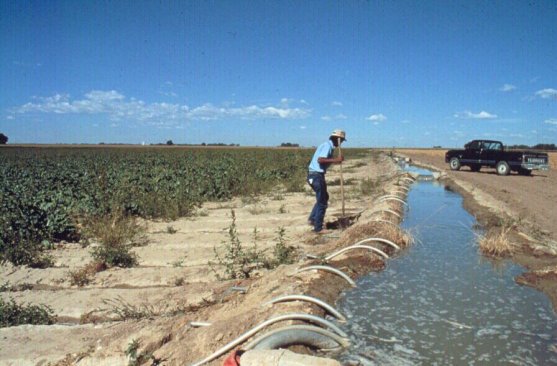Colorado State University
FROM THE GROUND UP
agronomy news
June 1999
Volume 19
Issue 6

|
Colorado State University FROM THE GROUND UP agronomy news June 1999 Volume 19 Issue 6 |
 |
| Atmometers | A flexible tool for irrigation scheduling. by Troy Bauder |
| You can find the complete agronomy news June 1999, Volume 19 Issue 6 at http://www.colostate.edu/Depts/SoilCrop/extension/Newsletters/news.html |
| Atmometers | |||||||||||||||||||||||||||||||
| A flexible tool for irrigation scheduling. | by Troy Bauder
Assistant Water Quality Specialist Soil and Crop Sciences Colorado State University |
||||||||||||||||||||||||||||||
| Irrigation scheduling based upon crop ET (evapotranspiration) is often
perceived as too difficult or too time consuming for many producers and
crop advisers. However, there are tools available that reduce the
work and the complexity associated with sound ET-based irrigation scheduling.
Atmometers are one of these tools. The primary purpose of these instruments
is to provide actual crop ET at any field location they are installed.
This information is visually displayed on a site tube mounted in front
of a ruler on the instrument. Reading the site tube is as easy as
reading a rain gauge. Therefore, a grower or consultant can use an atmometer
to quantitatively gauge how crop water use varies with changing weather
conditions.
Essentially, an atmometer acts as mini-weather station that, when properly installed, will provide reference ET (ETr) at a reasonable cost and with little effort. They are easy to install and require little maintenance. Studies conducted by CSU and the USDA in Fort Collins show that an atmometer will provide ETr values that closely match ETr calculated from weather station data (Figure 1). This ability to provide reliable ET makes atmometers especially useful for areas that do not have nearby weather stations or for people that do not have ready access to this information. A consultant or grower can install an atmometer to help schedule irrigations for many fields within a several mile radius. Also ET data from an atmometer may be more convenient and site specific than other sources. Atmometers basically consist of a wet, porous ceramic cup mounted on top of a cylindrical water reservoir. The ceramic cup is covered with a green fabric (canvas or Gor-Tex®) that simulates the canopy of a crop. The reservoir is filled with distilled water that evaporates out of the ceramic cup and is pulled through a suction tube that extends to the bottom of the reservoir. Underneath the fabric, the ceramic cup is covered by a special membrane that keeps rain water from seeping into the ceramic cup. A rigid wire extending from the top keeps birds from perching on top of the gauge. Atmometers are typically mounted on a wooden post near irrigated fields. A good location for placement is a border ridge in an alfalfa field. However, you may also locate the instrument alongside a dirt road if surrounded by low-growing irrigated crops. The site should represent average field conditions. Do not install near farm buildings, trees, or tall crops that may block the wind. Additionally, avoid placement near dry, fallow fields. The top of the ceramic cup should be 39 inches above the ground. The manufacturer of a modified atmometer sold in Colorado (ETgage®) provides detailed instructions on how to install and maintain their instrument. The following is a brief description of how to use an atmometer to help
schedule irrigations.
When using any ET-based irrigation scheduling, field verification of soil moisture status is a good idea. Field probing can confirm needed irrigation and provide confidence in using ET-based scheduling. An atmometer can also be used in conjunction with computer scheduling software such as Cropflex, especially if users do not have internet access. This tool can also help growers deal with salinity problems by providing ET over a period of time to determine leaching rations. Growers interested in trying an atmometer for a season should contact your regional CSU Cooperative Extension water specialist. |
|
||||||||||||||||||||||||||||||
| Figure 1. Comparison of Atmometer ET to Penman ET. Source
Bausch and Altenhofen.
Cumulative ET (inches)
|
|||||||||||||||||||||||||||||||
Table 1. Examples of allowable depletion for corn for typical
Colorado sandy loam soil.
|
| agronomy news
is a monthly publication of Cooperative Extension, Department of Soil & Crop Sciences, Colorado State University, Fort Collins, Colorado. Web Site: http//www.colostate.edu/Depts/SoilCrop/extens.html The information in this newsletter is not copyrighted and may be distributed
freely. Please give the original author the appropriate credit for
their work.
Reagan Waskom
Jerry Johnson
Direct questions and comments to:
|
Extension staff members are:
Troy Bauder, Water Quality
|